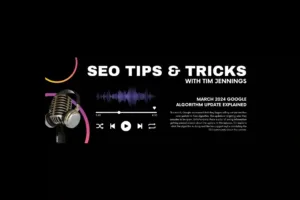What does ranking on Google for a keyword mean? When someone searches a keyword on Google, the search engine will display a list of websites and pages deemed most authoritative and relevant in their Search Engine Results Page (SERP). The higher you rank on Google, the more likely it is that users will click on your link over others. If you want to learn exactly how we helped a client start ranking #1 for a high-volume keyword in 1 month, download our case study!
As an SEO-first digital marketing agency, we’re all about organic search strategy and getting that coveted #1 position on SERPs (Search Engine Results Page) for as many keywords as possible. Your blog and website ranking #1 on Google for a keyword isn’t a result of luck; it takes strategy and a lot of hard work. Here’s how we got 1 of our clients to rank #1 on Google for a high-volume keyword in a little over a month.
The Client
Our client was already appearing on the first page of search engines for plenty of keywords, thanks to their optimized website, the blogs we create for them (part of our SEO services), and some of the blogs their team creates, too. But for the most part, these were low-volume keywords.
According to SEMRush, volume refers to the average monthly number of search queries for a given keyword in the last twelve months.
If a keyword has a volume of 10, that means around ten people a month search that keyword. Our client ranks #1 on Google mostly for keywords with volumes of 10 to less than 200. Don’t get us wrong – targeting low volume keywords is actually an important part of SEO strategy! Plus, if you’re like our client, you have an extremely niche audience so it makes sense if the keywords you’re targeting aren’t high-volume.
That said, we still wanted our client to rank for higher volume keywords as well. And in 1 month, we got their website in position 1 on Google for a high-volume keyword. How? Take a look at our strategy.

The Strategy
Back in the day, the way you got your website to appear first on search engines was by pumping out a ton of articles that targeted keywords. None of those articles had to be related or part of a series. Today, however, Google isn’t interested in how many different blogs you can churn out. They want to know that you’re the authority on a topic.
That’s where the pillar and cluster model comes in.
Our Client’s Pillar and Cluster Model
The pillar and cluster model is simply 1 really long blog (called a pillar page) on 1 topic that covers several subtopics and links to individual blogs that cover each of those subtopics in depth (these are called topic clusters). This lets Google know that you’re well-versed in different facets of the topic, showing them you’re an expert in the field.
We created a pillar page for our client that covered 1 topic split into 5 subtopics. Then, we created 5 cluster topic blogs (think of them as support blogs for the pillar page). Beyond typical blog optimization, we made sure:
- The pillar page targeted keywords and semantic keywords related to the topic
- The pillar page linked to all of the cluster topics
- The cluster topic blogs targeted keywords and semantic keywords related to the subtopic it was covering
- The first link in each cluster topic blog was the pillar page
And then we waited.

The Results
At that time we published the pillar page and cluster topics, a certain high-volume keyword was considered lost, meaning we ranked so low for it that SEO tools couldn’t pick up what SERP we appeared on for that keyword. That keyword is actually the target audience of our client – muy importante! It’s essentially the most relevant keyword our client could rank for.
1 day, we saw that keyword jump from being lost to ranking in position 40. SEMRush, the SEO tool we use, showed us the jump was because of the pillar page we just published. The keyword crawled its way higher until after two weeks, it suddenly lept from position 30 to position 5 overnight. It continued to climb up during the rest of the month.
Just 1 week into the following month, that keyword started ranking in the #1 position. Five months later, it’s still in the #1 position. That means every month when thousands of people Google that keyword, our client’s pillar page comes up first, directing thousands of visitors to their website and leading to many conversions.

Download Our Case Study
Ready to start ranking #1 on Google? Download our case study and start implementing the pillar and cluster model! Investing time and money in blogs that do nothing for your SEO is frustrating. The reason we recommend the pillar and cluster model is because we’ve seen how fast and effective it is! If it didn’t work, we wouldn’t advise it. You can download our case study below for free!
Ranking #1 on Google FAQs
Ranking on Google drives organic traffic to websites. Being in the top position on the first page of Google increases visibility and credibility, leading to more clicks. It also helps businesses and organizations establish authority in their industry and can lead to higher conversion rates.
A SERP, or Search Engine Results Page, is a list of web pages that appear in response to a user’s search query on a search engine like Google. This page displays a combination of organic and paid results, with the most relevant and high-quality websites ranking at the top.
A Google position refers to the ranking of a website on the SERP for a specific keyword or search query. The higher the position, the closer the website is to the top of the search results, making it more visible and likely to receive clicks from users.
Low-volume keywords are search terms that have a low number of monthly searches, typically under 1,000. These keywords may be more specific and targeted, making them less competitive but potentially more valuable to your target audience. On the other hand, high volume keywords are search terms that have a high number of monthly searches. These keywords are usually broader and more generic, making them highly competitive but also reaching a larger audience.





